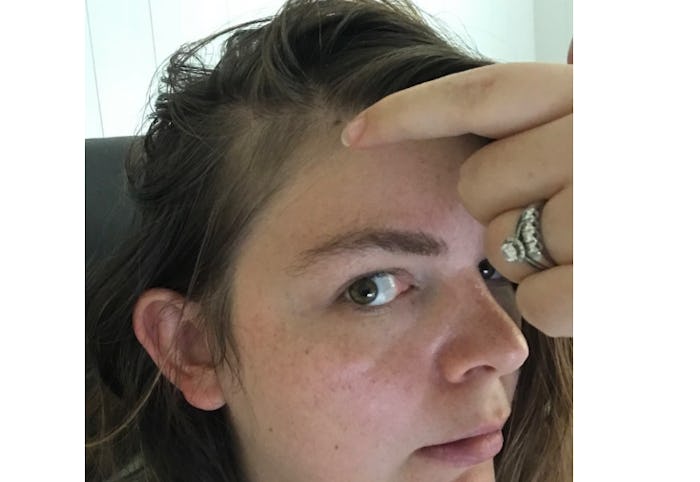Life

Guys, What Is This Postpartum Hair Loss At The Temples?
When I thought about things that happened to pregnant women postpartum, I was prepared for the stretch marks, the hormones, and obviously the exhaustion involved with bringing a newborn home. What I wasn’t prepared for was the hair loss. I knew my hair could potentially thin out since I heard that’s what happens once you have a baby, but not completely fall out — as in balding. I was frantically Googling postpartum hair loss at temples when my son was about 2 months old. Y’all. I was not prepared. My hair remained thick everywhere else, but I suddenly noticed I had a receding hairline like Billy Crystal happening on the sides of my head. Bangs didn’t help. Parting my hair differently didn’t help. I mean, I know I still had more hair on the top of my head than Billy Crystal, but I couldn't help but wonder what in the world was happening. Would I end up looking completely bald like that?
Apparently, postpartum hair loss near your temples is pretty common, at least in my friend circle. I know of three other women, not including myself, who all lost hair around their temples after giving birth. Some of them had girls, and others had boys, including me. So why the hell does this happen? And why oh why is it growing back and sticking straight up? Seriously, no amount of hairspray or gel or anything can keep it down. It sticks up when I wear my hair up, it sticks up when I wear my hair down, and it’s super noticeable no matter how I part my hair. And while I’m glad I don’t look like Billy Crystal (or even Larry David) anymore, I can’t help but feel like I look like a mad scientist.
Well, the hair sticking straight up as it grows back just has to do with new baby hair. But why are my friends and I balding only at our temples in the first place? Testosterone. Dr. Jamil Abdur-Rahman, OB-GYN and one-half of the Twin Doctors for TwinDoctorsTV, tells Romper in an email interview that this type of hair loss is still considered "male pattern balding" — even though we are ladies —and that it has to do with elevated testosterone levels.
"The elevated testosterone levels may have affected the hair over the temples and the forehead area. When women have male babies they have elevated testosterone levels during and for a time after pregnancy. But even if they have girls, the testosterone levels can be elevated as well. This is because progesterone, one of the primary female hormones, is made from testosterone," Abdur-Rahman explains.
"Typically balding in only certain areas results from the hair follicles in that or those areas being especially sensitive to certain hormones ... Hair over the temples and the forehead tends to be more sensitive to the effects of testosterone. This sensitivity causes the hair follicles over the temples and the forehead to become inflamed and irritated over time with exposure to testosterone. With this, the hair cycles for the hair in these areas shortens and/or stops, and hair loss can result," he says.
And if you're lucky enough postpartum to not only have hair loss on your temples, but also have your hair thinning and falling out all over, this, of course, has to do with hormones as well. Your hair's life cycle, including its "resting phase," is altered because of the hormonal changes your body is going through to grow a human. Abdur-Rahman explains: "Our hair has a life cycle. The initial part of this life cycle is characterized by growth. During this time hair is lengthening. Hair spends 90 percent of its time in this growth phase. The second part of hair's life is characterized by rest, during which hair does not grow. Hair spends about 10 percent of its time in this resting phase. Once hair's resting phase is done, hair then falls out. With this, hair's life cycle is complete."
But when you're pregnant, your estrogen levels increase, which causes your hair to stay at the "resting phase" longer, says Abdur-Rahman — typically giving you thick, long, luscious locks. However, once you deliver, all that extra hair you accumulated falls out. And you may notice your hair all over the house.
If your hair loss is severe and you feel like you need to do something about it, there are some options. Ken L. Williams Jr., surgeon and founder of Orange County Hair Restoration in Irvine, California and author of Hair Transplant 360 – Follicular Unit Extraction tells Romper in an email interview, "Hair loss can be reversed, stabilized, or slowed down with medical stabilization. The options include Rogaine, DHT inhibitors, low-level laser therapy, platelet-rich plasma (PRP), and potentially a new novel treatment with stem cells from fat cells called the Stromal Tissue cell-enRiched treatment of Androgenic Alopecia via Novel Deployment (STRAAND). This is a new study that my center is currently participating in."
But for most women, unless they develop Alopecia Areata, where you develop circular bald spot patches all over your head, you probably won't have to get your hair (or scalp) medically fixed. And while annoying for the hair to grow back and stick straight up at the front of your head if you experienced hair loss at your temples, at least it's growing back. Eventually, your hair should go back to how it was pre-baby. Until then, god bless hats and bandanas.